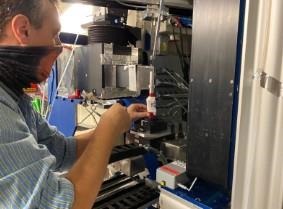By Kaine Korzekwa
Whether we like it or not, plastic is a major part of our lives. The production and use of plastics has been found to create a problem because “microplastics” are accumulating in our soils.

Andreas Cramer sets up a soil sample in front of the neutron beam. Neutrons are coming from the right side and the detector is to the left behind the sample. Neutron beams are used to image the movement of water through a soil sample containing microplastics.
Microplastics are tiny particles of plastic debris that are often found in the environment. Less than 5000 micromillimeters in size, they are the result from the disposal and breakdown of consumer products and industrial waste. With limited studies of the impacts on the environment, researchers in Europe wanted to dig deep to learn how microplastics may impact the flow of water through soil.
Andreas Cramer, a researcher from ETH Zurich in Switzerland, and his team believe that high amounts of microplastics in soil cause the soil to repel water. This is because plastics do not wet easily. Overall, their experiments tested soils with various amounts of microplastics to see how water hit the soil surface and flowed through the soil.
The study was published in the Vadose Zone Journal, a publication of the Soil Science Society of America.
The research team found that, in large quantities, microplastics begin to impact how water flows through soil. Fortunately, it is not likely that an entire area, such as a crop field, will contain this high amount of microplastics.
However, their data also showed how microplastics can concentrate or pool in certain areas, rather than being evenly distributed. This can cause issues in the soil in particular spots that have higher concentrations of the particles.
“If we take the example of an agricultural field, the uneven distribution of microplastics might cause an uneven distribution of water through the depths,” Cramer says. “Consequently, this could eventually impact the root architecture of plants. Spots with higher levels of microplastics in the top layer of soils could impact water availability for shallow rooting plants and, down the line, also nutrient availability.”
He adds that a worst-case scenario would be something like a dry “dead zone” where microbial activity is significantly reduced as well, which can impact the decomposition of organic material.

Scientists must be aware of their potential exposure to radiation, meeting safety protocols to limit to a safe level.
The scientists’ imaging techniques showed how water infiltration can be locally impeded because water doesn’t flow into regions with high levels of microplastics. Instead, it flows around them, which traps air. This results in an overall decreased water content and a slowing down of water filtering into the soil as well as changes in water configuration, so where water ends up.
Click here to see more...